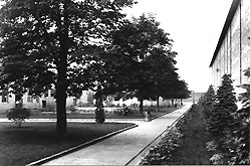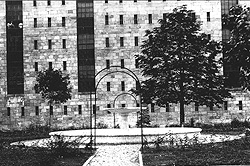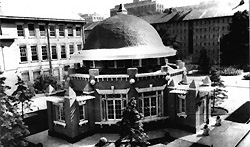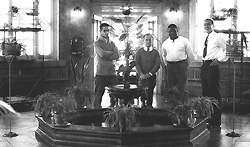|
Four:
THE ROSE MAN ( excerpts )
. . . . [Charles E.] Chapin, a confessed murderer, met Lawes in December 1919 at the prison hospital, where Chapin was a patient and Lawes was touring the prison before becoming its warden. At the time of his murder conviction, Chapin was 60-year-old editor . . . .
When Lawes returned as warden in January 1920, he found Chapin still in the hospital gravely ill and not expected to live. . . . . He offered Chapin the job of editor for the prison newspaper, which he eagerly accepted and was out of bed inside a week.
Chapin built the newspaper to one of the best prison newspapers in the country. The paper was eventually discontinued because of administrative circumstances.
Before long, Chapin asked the warden to be assigned to take care of the lawn. . . . Chapin requested funds to build a small flower garden in the prison yard.
". . . . I'll grow roses in that sand pit," said Chapin. From that time on, Charles Chapin was known as the Rose Man.
First the yard had to be cleared of refuse and topsoil had to be trucked in. By this time, the Rose Man had a gang of 30 men working for him. . . . . This project seemed to give him a new lease on life as he worked from dawn to sunset.
When it came time to order plants in the spring, there was not much money left in the
budget for this purpose, and because of this, the supply was a bit meager. The plants were shipped from a nursery in a nearby town.
The gardener followed them up with a visit to Sing Sing to see how they were being used. The gentleman met Chapin and gave him some practical suggestions. Soon, truckloads of plants were sent to Chapin from the gardener.
Chapin studied volumes of Luther Burbank's books and became a knowledgeable
horticulturist. The Rose Man turned the yard and surrounding areas into a parklike setting. When the flowers were in bloom, Chapin would personally deliver them daily to warden Lawes's office and the prison hospital.
By 1926, birds in great numbers started to roost in the tree tops and rose bushes. Chapin envisioned two huge birdhouse among the gardens of Sing Sing.
|
MORE ON 'ROSE MAN'
|
|
Other NYCHS web pages with information and images related to the Rose Man Charles E. Chapin:
|
With donations from his friends on the outside and help from some of the inmates, in three years the birdhouse was completed. . . .
For 10 years, Chapin had turned the arid landscape to a mass of color, life, and beauty, but in the summer of 1930, renovations at the prison resulted in the destruction of most of the gardens.
Chapin died of bronchial pneumonia on December 12, 1930, but after his death, the gardens were completely restored to their original beauty.
| 


